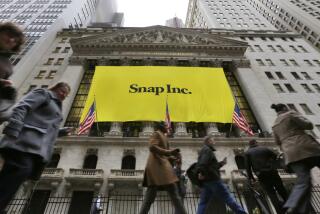Snap is ‘quickly running out of money,’ analyst says. The stock slides to a new low

Evan Spiegel, Snap Inc.’s chief executive, wants his struggling company to reach profitability next year. Before that, he has to address new concerns that the Santa Monica firm is depleting its cash.
Snap shares slid 6.4% on Tuesday to close at a new low of $7 after an analyst said the company behind the Snapchat video-messaging app was “quickly running out of money” and may need to raise new funding next year.
“Running Snap’s business has been a significant cash drain,” said the report from MoffettNathanson, a media and telecom research and analysis firm. “If the current cash burn holds, Snap will need to raise new funding in the back half of 2019!”
That would mark a significant blow for the company, which has faced a steady string of setbacks and challenges since its blockbuster initial public offering in March 2017.
Chief among them has been Snap’s inability to meaningfully grow its user base in the face of stiff competition from Instagram, the video and photo app owned by Facebook Inc. Another is a deeply unpopular redesign that alienated some of Snapchat’s most ardent users.
Snap has experienced some high-profile departures. Its chief strategy officer, Imran Khan, told employees in an email last month that he would leave Snap after helping find his replacement. Nine executives have departed from the company since its IPO .
In the MoffettNathanson report, analyst Michael Nathanson wrote that he expects Snap to fall far short of its goal of profitability next year as it tries to attract more users to Snapchat.
“While it is not surprising to see costs outweigh revenues for companies in hyper-growth mode, is Snap still considered to be one of these trailblazing companies?” Nathanson wrote. He said Snapchat might be reaching its peak as its daily active users, a key metric, fell in North America and all other markets in the second quarter of this year.
“We do not see Snap reaching profitability in the near future unless there are substantial expense reductions,” Nathanson said. He estimated a loss of more than $1.5 billion in 2019.
The research comes just days after a leaked memo to Snap employees obtained by Cheddar detailed how Spiegel wanted his company to break even by the fourth quarter of this year and “achieve full year profitability” in 2019.
Snap did not respond to a request for comment. It expects to have viability as a camera company that offers its users access to new technologies such as augmented reality. And last year, it boosted its advertising business by switching to an automated ad sales system.
Should Snap choose to raise more capital, it could do so several ways, including by selling bonds or more stock. More dramatic options include going private again or being acquired.
Any of the options would require articulating a clearer vision of how Snap plans to make a profit — no easy task for a company that probably wasn’t ready to go public when it did, said Gad Allon, a professor of management and technology at the Wharton School.
“The tough thing for Snap is that it’s not just competing with one firm, but multiple firms in Facebook, Instagram and WhatsApp that have a hold on the customers Snap is trying to get,” Allon said. “They’re stuck in a place where it’s increasingly more expensive for them to make money and not much easier to create revenue.”
“Is it possible to raise more money? Yes. Will that help it continue and survive? Yes. Is it a viable firm? I am not sure,” he added.
Allon said Snap may need to consider an overhaul of its business model to monetize its users as effectively as Facebook does. That could mean giving advertisers more access to user data, which in some ways is anathema to Snapchat’s principles on privacy and one-to-one communication.
Some analysts said Snap would not necessarily have to raise more capital. Brian Wieser of Pivotal Research Group said his models show Snap turning profitable at its current growth rates as long as it continues cutting some costs such as higher-end content.
Michael Pachter, an analyst for Wedbush Securities, said Snap has enough capital to last six quarters at its current spending rate. That doesn’t mean things are dire for the company, he said: The leaked memo to Cheddar about profitability and the hiring of former Amazon executive Tim Stone as chief financial officer in May signal the company is putting in place a plan to reverse its fortunes.
“Nathanson is right; if things don’t change, Snap will run out of cash,” Pachter said. “I am presuming that things will change, as evidenced by the management changes and Cheddar comments.”
UPDATES:
2:35 p.m.: This article was updated throughout with additional context and analyst comments.
9 a.m.: This article was updated throughout with Times staff reporting.
This article was originally published at 7:20 a.m.
More to Read
Inside the business of entertainment
The Wide Shot brings you news, analysis and insights on everything from streaming wars to production — and what it all means for the future.
You may occasionally receive promotional content from the Los Angeles Times.












